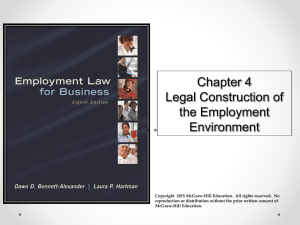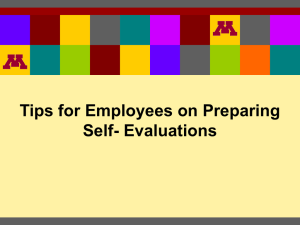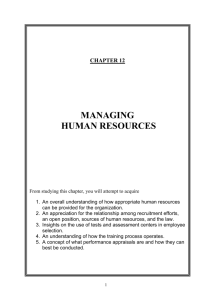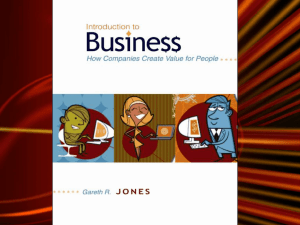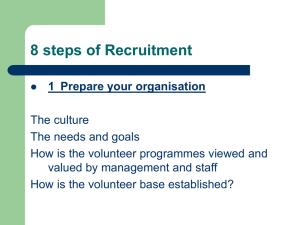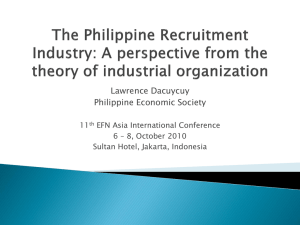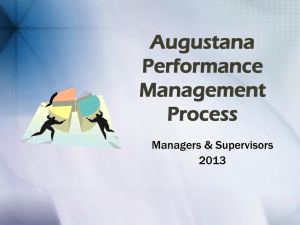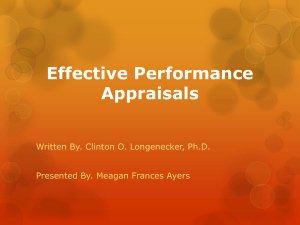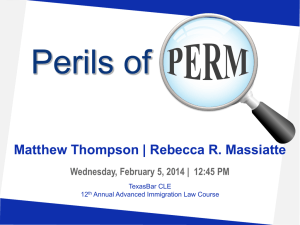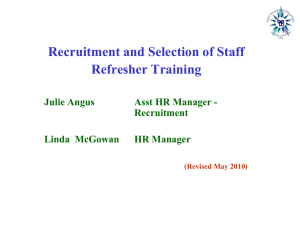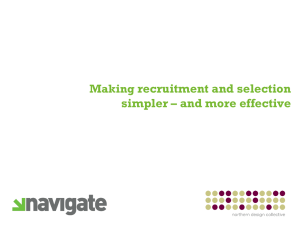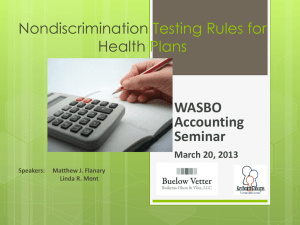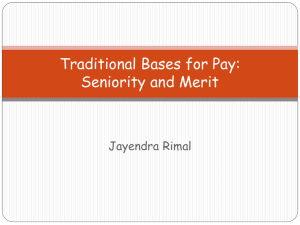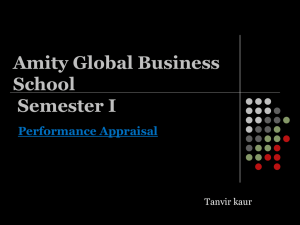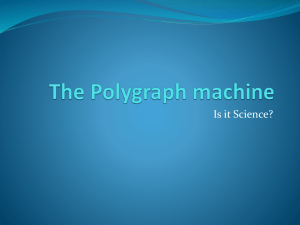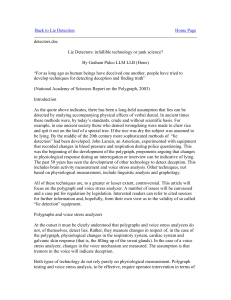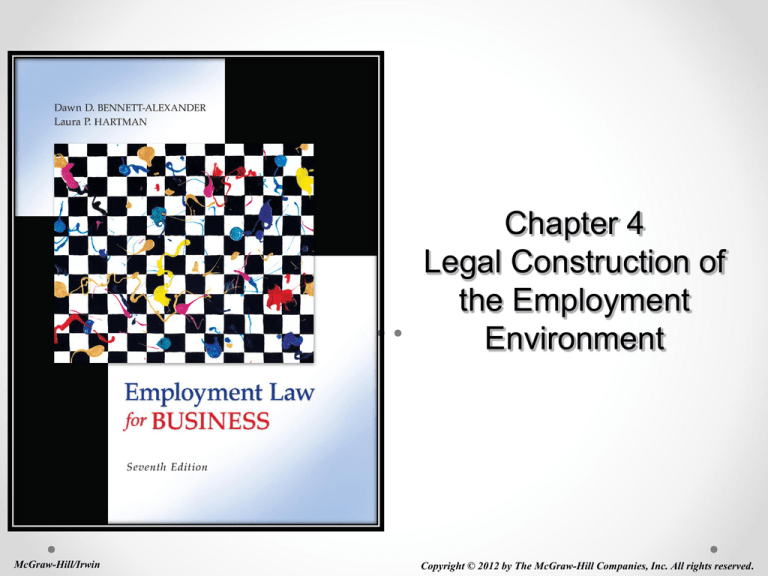
Chapter 4
Legal Construction of
the Employment
Environment
McGraw-Hill/Irwin
Copyright © 2012 by The McGraw-Hill Companies, Inc. All rights reserved.
Learning Objectives
Explain why employers might be concerned
about ensuring protections for equal opportunity
during recruitment, in particular
Describe how the recruitment environment is
regulated, by both statutes and common law
Describe the employer’s opportunities during the
information-gathering process to learn as much
as possible about hiring the most effective
worker
4-2
Learning Objectives
Explain how the employer might be liable under
the theory of negligent hiring
Identify the circumstances under which an
employer may be responsible for an employee’s
compelled self-publication, thus liable for
defamation
4-3
Learning Objectives
Explain the difference between testing for
eligibility and testing for ineligibility, and provide
examples of each
Identify the key benefits of performance
appraisal structures, as well as their areas of
potential pitfalls
4-4
Evolution of the Employment
Relationship
Recruitment of appropriate candidates
Hiring
Testing
Performance appraisals
4-5
Recruitment
First step in the evolution of the employment
relationship
Federal statutory regulation of recruitment
Title VII of the Civil Rights Act of 1964
Age Discrimination in Employment Act of 1967
Immigration Reform and Control Act of 1986
Vocational Rehabilitation Act of 1973 and the
Americans with Disabilities Act of 1990
4-6
Recruitment
State employment law regulation
Common law recruitment violations
Fraud
Misrepresentation
Material facts
4-7
Application of Regulation to
Recruitment Practices
Advertisements
Word-of-mouth recruiting
Promoting from within
Venue recruiting
Walk-in applicants
Neutral solicitation
4-8
Information Gathering and Selection
The application phase
The interview
Background or reference check
Negligent hiring
4-9
Exhibit 4.60 – Grounds for Negligent
Hiring Claim
4-10
Exhibit 4.8 - Where Do Employers Get
Their Info?
4-11
Exhibit 4.9 – Content on Candidates’ Web
Sites Leading Employers Not to Hire
4-12
Employer Liability and Protection
Reference checks – potential liability for
providing references
Compelled self-publication: Occurs when an exemployee is forced to repeat the reason for her or his
termination
“After-acquired evidence” in defense in wrongful
termination suits
Documentation of failure to hire
4-13
Exhibit 4.13 – Balancing the Interests in
the Testing Debate
4-14
Testing in the Employment
Environment
Preemployment testing
Tests to find the best individual for a position
Tests to ensure that the individual is free from
problems that would prevent her or him from
performing the position’s functions
Individual privacy
Testing is illegal when the invasion of privacy is
“substantially and highly offensive to the reasonable
person”
4-15
Legality of Eligibility Testing
Eligibility testing: Tests conducted to ensure
capability and qualification of potential employee
To be legally validated, an employer must show
that the eligibility test is:
Job-related
Consistent with business necessity
Job analysis data: Information about nature of
work and skills required to perform the work
4-16
Legality of Eligibility Testing
Validation: Evidence that shows that a test
evaluates precisely what it claims to evaluate
Test validity
Criterion-related validation
Content validation
Construct validation
4-17
Legality of Eligibility Testing
Integrity and Personality Tests
Used by 40 percent of Fortune 100 companies
Conscientiousness
job performance
basic intelligence testing is one of the best predictors
of job performance across all jobs
Physical Ability Tests
Medical Tests
4-18
Legality of Ineligibility Testing
Why testing is required?
Reduce workplace injury or to provide a safer working
environment
Predict employee performance or deter poor
performance
Reduce the employer’s financial responsibility to the
worker’s compensation system
4-19
Polygraphs
Polygraph: A lie-detecting device that measures
biological reactions in individuals when
questioned
A polygraph measures
Rate and depth of respiration
Cardiovascular activity
Perspiration
Accuracy rates range from 50 to 90 percent
4-20
Polygraphs
Federal Employee Polygraph Protection Act
(EPPA)
33 states have statutes prohibiting or restricting
the use of polygraphs in making employment
decisions
4-21
Drug and Alcohol Tests
Drug-Free Workplace Act of 1988
Only applies to federal employees
Some private sector firms use the act’s guidelines
Immunoassay test
Radioimmunoassay of hair
Drug-Free Workplace Act of 1998
4-22
Genetic Tests
Genetic Information Non-Discrimination Act
Issues
Employers may discriminate based on the potential
for a debilitating disease
Employees may not want to know results
Genetic testing is not perfect
Genetic irregularities may be considered protected
disabilities under the Americans with Disabilities and
Vocational Rehabilitation Act
4-23
Unique Considerations of HIV/AIDS
Testing
Why is it inappropriate?
For the test to be justified, it must serve a legitimate
business purpose
The test reports only the subject’s status as of several
weeks or months in the past
HIV-positive employee may be protected under
Federal Vocational Rehabilitation Act
Americans with Disabilities Act
4-24
Management Considerations: Testing
A workplace substance abuse program should
incorporate
A written abuse policy
A supervisory training program
An employee education and awareness program
Access to an employee assistance program
A drug testing program, where appropriate
4-25
Management Considerations: Testing
Corporate approaches
Mandatory testing
“Probable cause” testing
Random testing
4-26
Performance Appraisals, Evaluation,
and Discipline Schemes
Performance appraisal: A periodic assessment
of an employee’s performance
The purpose of performance appraisals
To identify those characteristics the employer hopes
the employee will accentuate
To dissuade the employee from exhibiting
characteristics not in keeping with the organization’s
objectives
The potential for discriminatory effect
4-27
Performance Appraisals, Evaluation,
and Discipline Schemes
Realities about performance evaluations
Employer might be liable for negative references
No need to lower its standards or qualifications to
accommodate employee’s or applicant’s needs
Objective measures for appraisal can be used
Performance incentive systems can be effective
Legal challenges found mostly in the areas of
implementation, monitoring and accountability
4-28
Legal Implications of Performance
Appraisal Systems
Disparate impact
Four-fifths rule
Validation
Disparate treatment
Employees rated subject to different criteria
4-29
Legal Implications of Performance
Appraisal Systems
Defamation
False information/evaluation
Negligent performance evaluations
Negligence in conducting a performance evaluation
4-30
Discipline
“Just cause” disciplinary approach
How is “just cause” determined?
Due process
Adequate evidence
Appropriateness of penalty
Documentation
Progressive discipline
4-31
Management Tips
Maintain proper documentation of performance
appraisals
Train supervisors on non-biased reporting and
evaluations
Take precautions against inappropriate
disclosures
Conduct appraisals as and when stated in the
employee manual or other materials
4-32

